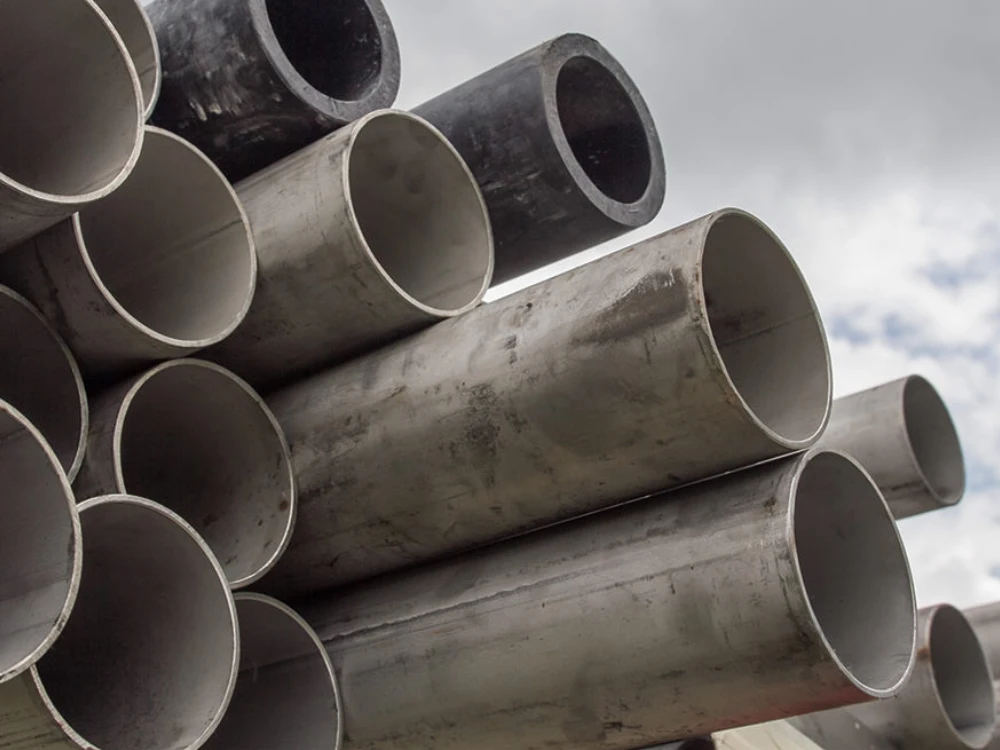
탄소강 파이프 은 견고성, 내식성 및 용접성 때문에 많은 애플리케이션에서 선호되는 소재입니다.
그러나 여러 프로젝트에서 탄소강 파이프의 일관성, 규정 준수 및 신뢰성을 보장하려면 탄소강 파이프 치수 세부 정보에 의존해야 합니다. 잘못된 치수나 잘못된 사양 해석은 운영상의 문제와 워크플로우 중단으로 이어질 수 있습니다.
그렇다면 탄소강 파이프의 크기를 올바르게 표현하는 방법은 무엇일까요?
이해를 돕기 위해 다음과 같은 측면에서 해석합니다:
- 파이프 치수에 대한 중요 매개변수
- 탄소강 파이프 사이즈 차트
- 탄소강 파이프와 스테인리스 파이프에 대한 서로 다른 표준
- 치수(ASME B36.10M 및 ASME B36.19M)
강관 치수의 중요 매개변수
강관의 크기는 주로 외경(OD), 벽 두께(WT), 스케줄 및 길이와 같은 여러 측면에서 설명됩니다.
이러한 치수 매개변수는 일반적으로 강관 제조 및 선택 프로세스에서 중요한 역할을 합니다.
적용 분야와 산업에 따라 다른 치수 매개변수가 필요할 수 있으므로 올바른 강관을 선택하려면 강관의 이러한 측면을 이해하고 설명하는 것이 중요합니다.
탄소강 파이프 치수 및 일정 차트
강관 크기 표준 - ASME B36.10M 및 ASME B36.19M
이는 강관을 규제하는 데 사용되는 치수 및 치수 표준입니다. 주요 차이점은 적용 가능한 강관 유형과 적용 분야에 있습니다:
ASME B36.10M
- ASME B36.10M은 주로 용접 및 이음매 없는 탄소강 파이프에 적용됩니다.
- 탄소강 파이프는 일반적으로 급수 시스템, 액체 또는 가스 이송, 일반 구조용 등 일반 산업 분야에 사용됩니다.
- ASME B36.10M은 스케줄 시스템을 사용하여 스케줄 40, 스케줄 80 등과 같이 벽 두께가 다른 강관을 표현합니다.
ASME B36.19M
- 특히 용접 및 이음매 없는 튜브를 포함한 스테인리스 스틸 및 니켈 합금 튜브에 적합합니다.
- 이 표준은 일반적으로 화학 산업, 석유 및 가스 추출, 식품 가공과 같이 더 높은 내식성이 요구되는 분야에서 사용됩니다.
- ASME B36.10M과 달리 B36.19M은 스케줄링 시스템을 사용하지 않고 파이프의 실제 벽 두께(실제 두께)를 직접 제공합니다.
일반적으로 ASME B36.10M은 탄소강 파이프와 용접 및 이음매 없는 파이프의 일반적인 적용에 적합하며, ASME B36.19M은 스테인리스강 및 니켈 합금 파이프, 특히 부식이 심한 환경의 적용에 특히 적합합니다. 어떤 표준을 선택할지는 필요한 재료와 적용 분야에 따라 다릅니다.
강관 크기에서 SCH 는 무엇을 의미합니까?
파이프 사이즈의 SCH(스케줄)는 일련의 파이프 벽 두께를 표시하는 표준화된 시스템을 의미합니다. 이는 ANSI B36.10 및 36.19 표준에서 중요한 사양입니다. SCH 번호는 벽 두께를 직접적으로 나타내는 것이 아니라 다른 두께 계열을 나타내며, 숫자가 클수록 벽이 두꺼워지고 압력 저항이 높아집니다.
일반적인 SCH 등급은 SCH 5S에서 SCH 160까지 다양하며, 각각 특정 압력 요구 사항에 맞게 설계되었습니다. 예를 들어, 1인치 파이프의 벽 두께는 SCH 40인지 SCH 80인지에 따라 다르지만 외경은 동일하게 유지됩니다. 이러한 표준화는 특정 산업 애플리케이션 및 압력 요구 사항에 맞는 올바른 선택을 보장하는 데 도움이 됩니다.
스케줄 40 강관 및 80 수단 및 치수
일정 40 그리고 일정 80 는 다양한 벽 두께의 강관 사양을 설명하는 데 사용됩니다. 자세한 내용은 스케줄 40과 스케줄 80 파이프의 차이점.
다음은 스케줄 40 및 스케줄 80의 일반적인 탄소강 파이프 크기입니다(참고용으로만 제공됨):
스케줄 40 강관
- 외경(OD): 일반적으로 1/8인치에서 24인치 사이입니다.
- 벽 두께: 일반적으로 2.77mm(0.109인치)에서 17.48mm(0.688인치) 사이입니다.
- 이러한 유형의 스케줄링은 급수 시스템, 환기 덕트 등과 같은 일반 산업 애플리케이션에서 일반적으로 사용됩니다.
스케줄 80 강관
- 외경(OD): 일반적으로 1/8인치에서 24인치 사이입니다.
- 벽 두께: 보통 3.73mm(0.147인치)에서 22.23mm(0.875인치) 사이입니다.
- 이러한 유형의 스케줄링은 일반적으로 고압 공기 또는 증기 파이프 라인과 같이 높은 압력 허용 오차가 필요한 애플리케이션에서 사용됩니다.
위의 치수는 참고용이라는 점에 유의하세요. 특정 프로젝트에서는 프로젝트의 요구 사항과 파이프라인의 목적에 따라 적절한 일정과 크기를 선택해야 합니다. 탄소강 파이프의 자세한 치수는 일반적으로 공급업체에서 제공하는 관련 표준 또는 사양서에서 확인할 수 있습니다.
공칭 파이프 크기(NPS)란 무엇인가요?
공칭 파이프 크기(NPS)는 파이프의 표준 크기를 나타내며 외경을 설명합니다. NPS는 일반적으로 인치로 표시됩니다.
미국 제조 표준을 기준으로 합니다. 실제 파이프 크기를 직접 보여주지는 않습니다. 하지만 파이프를 찾고 선택하는 데 사용되는 근사치입니다.
NPS는 종종 파이프의 실제 크기를 결정하기 위해 파이프 벽 두께와 함께 사용됩니다. 석유 산업에서 일반적인 공칭 파이프 크기는 1/8인치에서 120인치까지 다양하며, 각 크기에는 해당되는 실제 외경이 있습니다.
파이프라인 크기 선택은 일반적으로 유량, 압력 및 온도와 같은 요소의 영향을 받습니다. 이러한 요소는 파이프라인의 액체 또는 기체에 영향을 미칩니다.
일부 국가 및 지역에서는 미터법을 사용합니다. NPS 대신 공칭 직경(DN) 표준을 사용하여 파이프 치수를 밀리미터 또는 센티미터로 표현할 수 있습니다.
이러한 차이점에도 불구하고 NPS는 특히 미국 또는 북미 시장과 관련된 프로젝트에서 전 세계적으로 가장 일반적으로 사용되는 파이프 크기 조정 표준 중 하나로 남아 있습니다.
따라서 국제 엔지니어링 프로젝트에서는 여러 지역의 파이프 크기 표준을 고려해야 합니다. 필요에 따라 조정하고 변환하세요.
DN(공칭 직경)이란?
DN(공칭 직경)은 국제 표준입니다. 파이프, 밸브, 플랜지와 같은 배관 구성 요소의 크기를 나타냅니다.
DN은 일반적으로 밀리미터 단위로 측정됩니다. 파이프 또는 파이프 구성 요소의 내경 또는 외경을 나타냅니다.
DN 값은 파이프 또는 파이프 구성 요소의 표준 크기를 나타냅니다. 실제 내경 또는 외경을 나타내지는 않지만 크기가 다른 파이프 구성 요소를 식별하는 데 사용됩니다.
실제 외경이 50mm(5cm)인 수도관이 있다고 가정합니다. 표준화 과정에서는 공칭 직경이 50mm임을 나타내는 DN50이라고 부릅니다.
올바른 강관 크기를 선택하는 방법은?
공칭 파이프 크기(NPS):
위에서 언급했듯이 이것은 파이프의 직경을 설명하는 데 사용되는 표준 파이프 크기입니다. 실제 직경이 아니라 식별을 위해 사용되는 공칭 값입니다.
외경(OD):
이는 인치 또는 밀리미터 단위로 측정된 파이프의 실제 외경을 나타냅니다. 피팅 및 기타 구성 요소와의 호환성을 결정하므로 OD를 정확하게 지정하는 것이 중요합니다.
벽 두께(WT):
이 측정값은 파이프 벽의 두께를 나타내며 인치 또는 밀리미터 단위로 측정할 수 있습니다. 이는 파이프의 강도와 압력 등급을 결정하는 데 매우 중요합니다.
스케줄 번호:
스케줄 번호는 파이프의 벽 두께를 나타내는 데 사용되는 명칭입니다. 이는 NPS 및 벽 두께와 관련이 있으며 숫자로 표시됩니다(예: 스케줄 40, 스케줄 80).
길이:
파이프의 길이는 일반적으로 피트 또는 미터 단위로 지정됩니다. 프로젝트 요구 사항을 충족하려면 길이를 정확하게 지정하는 것이 중요합니다.
강관 치수를 설명할 때는 이러한 모든 매개변수를 정확하게 제공하는 것이 중요합니다. 이를 통해 용도에 맞는 파이프를 올바르게 선택하고 설치할 수 있습니다. 파이프 크기를 결정하려면 다음을 참조하세요. 유니센 강관 전문가.
